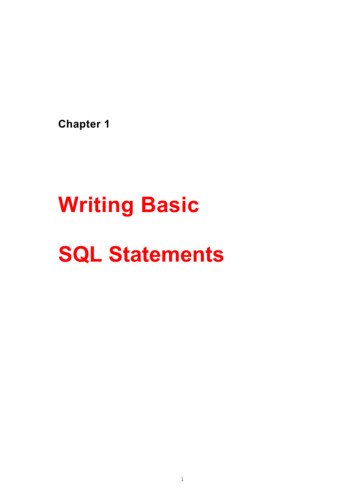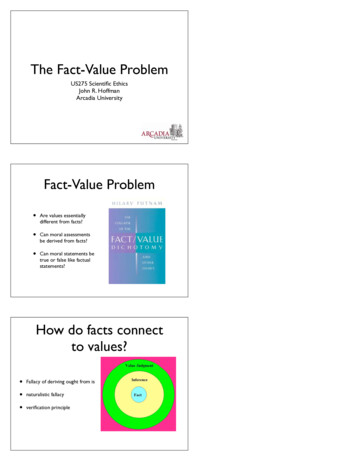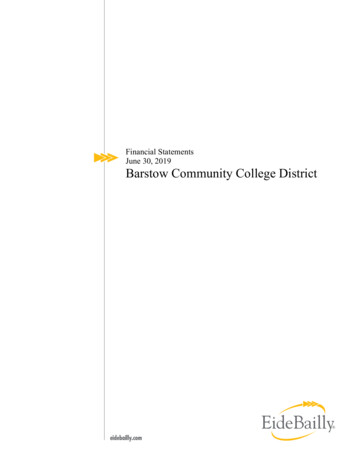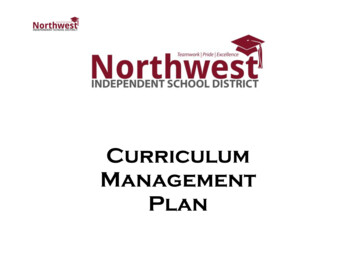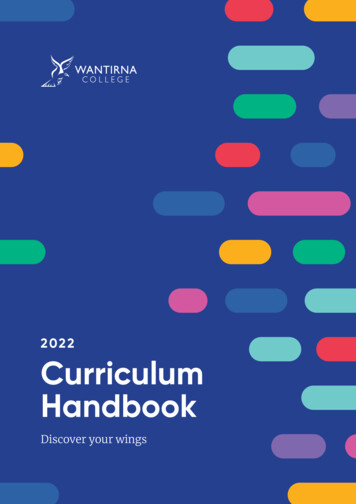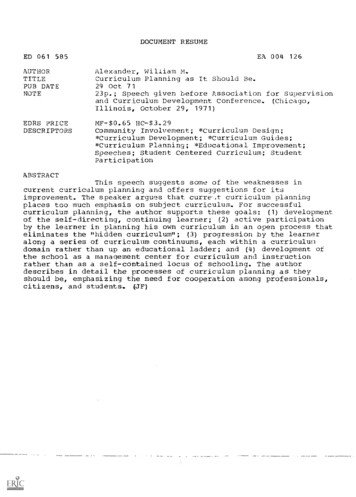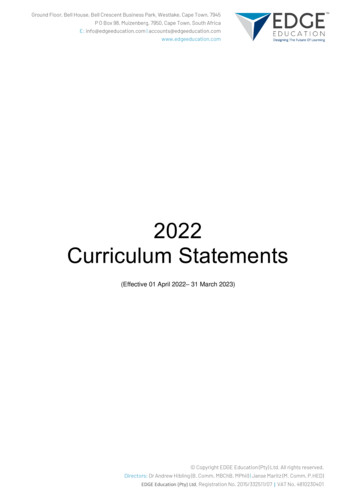
Transcription
Ground Floor, Bell House, Bell Crescent Business Park, Westlake, Cape Town, 7945P O Box 98, Muizenberg, 7950, Cape Town, South AfricaE: info@edgeeducation.com 2Curriculum Statements(Effective 01 April 2022– 31 March 2023) Copyright EDGE Education (Pty) Ltd. All rights reserved.Directors: Dr Andrew Hibling (B. Comm, MBChB, MPhil) Janse Maritz (M. Comm, P.HED)EDGE Education (Pty) Ltd, Registration No. 2015/332511/07 VAT No. 4810230401
Ground Floor, Bell House, Bell Crescent Business Park, Westlake, Cape Town, 7945P O Box 98, Muizenberg, 7950, Cape Town, South AfricaE: info@edgeeducation.com LE OF CONTENTS1.2.3.PAGEFinancial Accounting Programme11.1.Bookkeeping to Trial Balance1–31.2.Payroll & Monthly SARS Returns3–61.3.Computerised Bookkeeping1.4.Business Literacy10 – 131.5.Financial Statements13 – 151.6.Cost and Management Accounting15 – 171.7.Income Tax Returns17 – 201.8.Business Law and Accounting Control20 – 221.9.Corporate Strategy22 – 246 – 101.10. Management Accounting and Control Systems24 – 251.11. Financial Reporting and Regulatory Frameworks25 – 27Office Administration Programme282.1.Business and Office Administration 128 – 312.2.Marketing Management and Public Relations31 – 342.3.Business Law and Administrative Practice34 – 372.4.Business and Office Administration 237 – 392.5.Human Resources Management and Labour Relations40 – 432.6.Economics43 – 452.7.Business and Office Administration 345 – 462.8.Management46 – 49Business Management Programme503.1.Business Management 150 – 523.2.Office and Legal Practice52 – 563.3.Business Management 256 – 583.4.Business Management 358 – 603.5.Financial Management and Control60 – 62ii Copyright EDGE Education (Pty) Ltd. All rights reserved.Directors: Dr Andrew Hibling (B. Comm, MBChB, MPhil) Janse Maritz (M. Comm, P.HED)EDGE Education (Pty) Ltd, Registration No. 2015/332511/07 VAT No. 4810230401
Ground Floor, Bell House, Bell Crescent Business Park, Westlake, Cape Town, 7945P O Box 98, Muizenberg, 7950, Cape Town, South AfricaE: info@edgeeducation.com inancial Accounting Programme1.1.Bookkeeping to Trial BalanceAn introduction to business, bookkeeping and accounting Discuss the history and origin of accounting and the double entry system;identify the users and uses of financial information;critically evaluate the various forms of business ownership (sole traders, partnerships, companies andclose corporations);describe the developments which have taken place in the field of accounting, making specificreference to internal vs. external reporting;illustrate the bookkeeping and accounting cycle graphically;outline the types of transactions that can take place in a business;define common accounting terms including source document, journal, bank reconciliation, generalledger, trial balance, income statement and balance sheet;analyse transactions under the accounting equation;define assets, non-current assets and current assets;define liabilities, non-current liabilities and current liabilities;explain the business entity rule, and analyse transactions under the accounting equation taking thisprinciple into account;explain what is meant by a ‘proprietary account’ and distinguish between capital and drawingsaccounts;define profit, income, expenses and cost of sales; andexplain and apply the rules of double entry (including cross references).Value Added Tax and source documents Explain what Value Added Tax (VAT) is;illustrate how the VAT system works in terms of input VAT and output VAT;identify the different VAT supply categories (including standard rated, zero-rated and exempt supplies,as well as non-allowable items);compare the payments vs. the invoice bases according to which vendors may be registered for VAT;explain what a valid tax invoice looks like;differentiate between the various source documents used by businesses to record varioustransactions;perform basic VAT calculations (VAT exclusive and VAT inclusive amounts as well as mark-ups andgross margins); andcomplete a VAT201 form accurately and correctlyRecording cash transactions Explain the difference between the cash flow and the profit of a business;identify the different subsidiary journals and the transactions unique to each of these journals;define cash transactions;explain the purpose of every column in each of the three cash journals;record cash transactions in the cashbook receipts;record cash transactions in the cashbook payments;record cash transactions in the petty cash journal;1 Copyright EDGE Education (Pty) Ltd. All rights reserved.Directors: Dr Andrew Hibling (B. Comm, MBChB, MPhil) Janse Maritz (M. Comm, P.HED)EDGE Education (Pty) Ltd, Registration No. 2015/332511/07 VAT No. 4810230401
Ground Floor, Bell House, Bell Crescent Business Park, Westlake, Cape Town, 7945P O Box 98, Muizenberg, 7950, Cape Town, South AfricaE: info@edgeeducation.com accounts@edgeeducation.comwww.edgeeducation.com account for VAT in the journals by recording a variety of different cash transactions that involvestandard rated, zero-rated, exempt and non-allowable items;post the cash journals to the general ledger and balance the general ledger accounts; andindex the general ledger accounts with their respective balances in a trial balance;Recording credit and sundry transactions Explain why offering credit can benefit a business, while also focusing on the risks associated withoffering credit to customers;define credit transactions;record credit purchases in the creditors journal from original credit invoices;record original credit notes in the creditors allowances journal;record credit sales in the debtors journal from duplicate credit invoices;record duplicate credit notes in the debtors allowances journal;record sundry transactions in the general journal;complete a comprehensive exercise in which all subsidiary journals are combined;account for VAT in the journals by recording a variety of different transactions that involve standardrated, zero-rated, exempt and non-allowable items;post a completed set of subsidiary journals to the general ledger;balance the ledger accounts and draft a trial balance.Inventory systems Explain why some businesses choose not to use a perpetual inventory system, but a periodic systeminstead;calculate cost of sales using a periodic inventory system;demonstrate the working of the purchases and purchases returns accounts under a periodic inventorysystem;demonstrate the working of the carriage on purchases and similar accounts that affect the calculationof cost of sales under a periodic inventory system;analyse inventory-related transactions under the accounting equation when using a periodic inventorysystem;record inventory-related transactions in the subsidiary journals when using a periodic inventorysystem; andexplain which one of the two inventory systems is most desirable for a business to make use of.Individual accounts for debtors and creditors, and supplier and general ledger reconciliations Explain why it is important to have separate debtors’ accounts in a separate ledger;illustrate the structure of individual accounts in the debtors ledger;explain why it is important to have separate creditors’ accounts in a separate ledger;illustrate the structure of individual accounts in the creditors ledger;explain the control account system;demonstrate how the debtors list is reconciled with the debtors control account in the general ledger;demonstrate how the creditors list is reconciled with the creditors control account in the general ledger;demonstrate how errors and omissions in the books of the business are corrected by means ofcorrective entries in the general journal and/or creditor’s individual account;demonstrate how errors on the statement received from the creditor are outlined on the creditorsreconciliation statement (remittance advice); andprepare a General ledger reconciliation statement.2 Copyright EDGE Education (Pty) Ltd. All rights reserved.Directors: Dr Andrew Hibling (B. Comm, MBChB, MPhil) Janse Maritz (M. Comm, P.HED)EDGE Education (Pty) Ltd, Registration No. 2015/332511/07 VAT No. 4810230401
Ground Floor, Bell House, Bell Crescent Business Park, Westlake, Cape Town, 7945P O Box 98, Muizenberg, 7950, Cape Town, South AfricaE: info@edgeeducation.com accounts@edgeeducation.comwww.edgeeducation.comThe bank reconciliation process Discuss the daily banking process of a business;understand the information included in a bank statement;outline the steps in the bank reconciliation procedure;compare the credits on the bank statement with the bank column in the cashbook receipts to identifyany differences which need to be updated in the cashbook;compare the debits on the bank statement with the bank column in the cashbook payments to identifyany differences which need to be updated in the cashbook;total the cashbook receipts and cashbook payments, and post to the bank account in the generalledger;transcribe the closing bank statement balance onto the bank reconciliation statement;clear any remaining amounts from the previous month’s reconciliation statement and carry forwardany unresolved amounts to the current month’s reconciliation statement;enter un-reconciled cashbook amounts in the bank reconciliation statement;interpret and investigate any outstanding items on the current month’s bank reconciliation statement;andidentify the alternative steps which may be followed when conducting a bank reconciliation.Drafting financial statements 1.2.apply lateral thinking with respect to double entries, journals, ledgers and the trial balance;interpret the balances/totals on a trial balance from a business perspective;demonstrate how to prepare the final accounts in the books of account at year-end;explain the difference between financial performance and financial position;prepare a simple income statement; andprepare a simple balance sheet.Payroll and Monthly SARS ReturnsBasic bookkeeping and VAT Differentiate between the various source documents used by businesses to record varioustransactions;identify the different subsidiary journals and the transactions unique to each of these journals;identify the accounts used in the general ledger;understand the accounting equation;define assets, non-current assets and current assets;define liabilities, non-current liabilities and current liabilities;define owner’s equity and differentiate between drawings and capital;define income and expenses;explain the rules of double entry;explain the purpose of a trial balance;distinguish between the monthly and yearly financial cycle of a business;revise the recording of transactions in the subsidiary ledgers;explain what Value Added Tax (VAT) is and illustrate how the VAT system works in terms of inputVAT and output VAT;3 Copyright EDGE Education (Pty) Ltd. All rights reserved.Directors: Dr Andrew Hibling (B. Comm, MBChB, MPhil) Janse Maritz (M. Comm, P.HED)EDGE Education (Pty) Ltd, Registration No. 2015/332511/07 VAT No. 4810230401
Ground Floor, Bell House, Bell Crescent Business Park, Westlake, Cape Town, 7945P O Box 98, Muizenberg, 7950, Cape Town, South AfricaE: info@edgeeducation.com accounts@edgeeducation.comwww.edgeeducation.com identify the different VAT supply categories (including standard rated, zero-rated and exempt supplies,as well as non-allowable items);calculate VAT amounts as well as VAT inclusive and VAT exclusive amounts for various transactions;explain the information that has to be included on an invoice and debit and credit notes for VATpurposes;compare the payments vs. the invoice bases according to which vendors may be registered for VAT;outline the different categories according to which VAT vendors can be classified;explain when VAT payments are due and the penalties and interest that will be charged on latepayments;distinguish between VAT avoidance and VAT evasion; andcomplete VAT returns accurately and completely.Plan, organise, implement, monitor and work within the payroll environment Identify the role and typical duties of a payroll administrator;distinguish between a payroll and a payroll form;outline a typical payroll cycle;discuss the important issues a payroll administrator needs to deal with, including training and resourceallocation, change management, statutory requirements and organisational procedures, prevention ofpayroll fraud, evaluation and review of payroll staff, reporting of deviations and implementingcorrective action;describe how a payroll administrator should go about developing procedures to meet specified needs(i.e. developing it in conjunction with users and agreeing the costs and benefits with decision-makers);andexplain how a payroll administrator could ensure that procedures are implemented.Record and validate input variations on employee records Discuss why it is important for a payroll administrator to verify employees’ contracts;outline the elements to be included in a contract of employment;explain the importance of capturing employee information correctly on the payroll system;recognise what a compensation package comprise of and distinguish between the different types ofremuneration;explain the importance of employee induction and the role the payroll administrator plays in thisprocess;describe how payroll is affected by the movement of employees and the processes that should befollowed by the payroll administrator when new employees are appointed, existing employees arepromoted or transferred or when the services of an employee are terminated;exhibit an understanding of the importance of payroll administrators implementing instructions fromexternal agencies quickly and correctly;understand that the payroll administrator has to evaluate and record variation to payroll records inorder to ensure that all data is accurate and reasonable, and that no unauthorised changes weremade to payroll records.Basic conditions of employment Outline and explain the main stipulations of the Basic Conditions of Employment Act No. 11 of 2002(as amended);calculate and explain normal time and overtime as well as the opportunity cost of each;4 Copyright EDGE Education (Pty) Ltd. All rights reserved.Directors: Dr Andrew Hibling (B. Comm, MBChB, MPhil) Janse Maritz (M. Comm, P.HED)EDGE Education (Pty) Ltd, Registration No. 2015/332511/07 VAT No. 4810230401
Ground Floor, Bell House, Bell Crescent Business Park, Westlake, Cape Town, 7945P O Box 98, Muizenberg, 7950, Cape Town, South AfricaE: info@edgeeducation.com accounts@edgeeducation.comwww.edgeeducation.com explain the various types of leave that an employee is entitled to during the course of his or heremployment;outline the implications of leave payments and leave encashment to the individual, the employer, andthe society as a whole; andrecord and validate employee records.Statutory registrations Explain and complete the statutory registration forms for a new business;explain the purpose, working and logistical arrangements with respect to Skills Development Levies(SDL), Unemployment Insurance Fund (UIF) and Pay-As-You-Earn (PAYE);explain the purpose, working and logistical arrangements with respect to the Compensation forOccupational Injuries and Diseases Act; anddemonstrate the claiming procedures for benefits from each of the designated statutory funds.Complete PAYE documents Calculate gross earnings for an employee, including allowances as well as company car and medicalaid fringe benefits;calculate ‘remuneration’ and ‘balance of remuneration’ as defined by SARS;calculate ‘PAYE remuneration’, ‘SDL remuneration’ and ‘UIF remuneration’ as defined by SARS; andcomplete a monthly EMP201 return reflecting the correct calculation and payment of PAYE, SDL andUIF to SARS.Accounting for payroll Calculate wages from either time records or a productivity scheme;make and record the correct deductions;record all payroll components in the appropriate wages or salaries register; andpost the wages and salaries registers as well as the cashbook payments to the general ledger to affectthe double entries for payroll.Computerised payroll Install and register a recognised accounting software package;navigate through the different menu options;create a new company selecting the correct pay frequencies;setup the company parameters;edit and create transaction codes;edit profiles for different pay frequencies;create employee master files and link them to the relevant profile;bring in year to date totals on employees previously calculated on a manual system;set up the default (permanent) tab of employees pay slips;edit employees’ periodic payslips according to information supplied for the pay period;process a payroll run for both weekly and monthly salaries;create a backup of the company data;run payroll and statutory reports; andprocess a pay period update moving the payroll form one pay period into the next.5 Copyright EDGE Education (Pty) Ltd. All rights reserved.Directors: Dr Andrew Hibling (B. Comm, MBChB, MPhil) Janse Maritz (M. Comm, P.HED)EDGE Education (Pty) Ltd, Registration No. 2015/332511/07 VAT No. 4810230401
Ground Floor, Bell House, Bell Crescent Business Park, Westlake, Cape Town, 7945P O Box 98, Muizenberg, 7950, Cape Town, South AfricaE: info@edgeeducation.com thly SARS returns and eFiling Submit an EMP201 on eFiling; andsubmit a VAT201 form on eFiling.Ethics and the registered Tax Practitioner 1.3.Contrast morals and ethics;explain and describe a code of conduct;identify and explain the principles of a code of conduct;adhere to a code of conduct;identify and understand the ethical issues in an organisation;explain the basic principles of internal control;identify the need for Tax Practitioners in South Africa;explain when a person should register with SARS as a Tax Practitioner;explain the procedures to be followed for registration as a Tax Practitioner;explain the reasons for regulation of the tax profession; andlist the benefits for professional membership of the South African Institute of Tax Professionals (SAIT).Computerised BookkeepingOffice ComputingIntroduction to computing Discuss the history of computers briefly;learn what a PC is and how it basically works;identify the main components of PC hardware;understand why upgrading a PC is important;identify various PC software applications;differentiate between hardware and software;understand the interaction between hardware and software using the IPOS cycle;understand what networks are used for;identify the basic components of networks; andexplain the advantages and disadvantages of using computers.The Windows Operating System Understand where the Windows concept comes from;learn how to use basic tools in Windows;learn how to log on to your PC;identify the desktop and the taskbar;identify objects in Windows;use the recycle bin;identify tooltips;identify common Window components;learn how to control multiple opened Windows;learn how to start a programme;use the help, support and search tools;6 Copyright EDGE Education (Pty) Ltd. All rights reserved.Directors: Dr Andrew Hibling (B. Comm, MBChB, MPhil) Janse Maritz (M. Comm, P.HED)EDGE Education (Pty) Ltd, Registration No. 2015/332511/07 VAT No. 4810230401
Ground Floor, Bell House, Bell Crescent Business Park, Westlake, Cape Town, 7945P O Box 98, Muizenberg, 7950, Cape Town, South AfricaE: info@edgeeducation.com accounts@edgeeducation.comwww.edgeeducation.com learn how to adjust PC hardware and PC software properties;learn how to change basic mouse properties;view the display properties;understand user accounts;add and remove programmes;learn what drivers are;use Windows Explorer to browse and create folders;open and navigate through the Windows Explorer structure;learn how to work with files and folders in Windows Explorer;create and save a document in Windows; andknow how to launch a programme.Working with Internet and Email Learn what e-mail is;distinguish between the Internet, e-mail and network e-mail;identify the various Outlook components;compose messages in Outlook;learn how to format messages;learn how to open a message;learn how to add an attachment to an e-mail;understand why and how to create e-mail folders;learn how to move messages to a folder;understand how contacts work in Outlook;learn how to add and delete contacts in the address book;use the help function in Outlook;work with electronic calendars;schedule appointments and meetings in an electronic diary;create and manage contacts in an electronic diary;understand Internet basics;distinguish between the intranet and the extranet;understand what viruses are;identify a web browser;understand what a Uniform Resource Locator (URL) is;identify the Microsoft Internet Explorer 9 Interface;use web-based tools;download programs and files from the web;understand the workings of a search engine; andsearch the web and get usable information.Working with Microsoft Word 2010 Work effectively and efficiently on MS Word.Working with Microsoft Excel 2010 Work with an Excel workbook;create and save a workbook;open and view a workbook;7 Copyright EDGE Education (Pty) Ltd. All rights reserved.Directors: Dr Andrew Hibling (B. Comm, MBChB, MPhil) Janse Maritz (M. Comm, P.HED)EDGE Education (Pty) Ltd, Registration No. 2015/332511/07 VAT No. 4810230401
Ground Floor, Bell House, Bell Crescent Business Park, Westlake, Cape Town, 7945P O Box 98, Muizenberg, 7950, Cape Town, South AfricaE: info@edgeeducation.com accounts@edgeeducation.comwww.edgeeducation.com navigate within a worksheet;format and edit an existing worksheet;print preview and print data; andwork and understand the tools within the following tabs: Home tab Insert tab Page Layout tab Formulas tab Data tab Review tab View tab Add-Ins tabWorking with Microsoft PowerPoint 2010 Work with PowerPoint slides;create and save a presentation;open and view a presentation;navigate within a presentation;format and edit an existing presentation;print preview and print slides; andwork and understand the tools within the following tabs: Home tab Insert tab Design tab Transition Tab Animation tab Slide Show tab Review tab View tabAccounting SoftwareInstallation and registration of accounting software Explain what the minimum hardware requirements are for installing accounting software on yourcomputer;choose the correct regional and date settings;install a printer driver;install the software;register the software as an educational version; andnavigate in the software.Accounting software language and navigation Relate standard bookkeeping terminology to the terminology used in the accounting software; andlearn how to navigate in the software package using the different navigational options.8 Copyright EDGE Education (Pty) Ltd. All rights reserved.Directors: Dr Andrew Hibling (B. Comm, MBChB, MPhil) Janse Maritz (M. Comm, P.HED)EDGE Education (Pty) Ltd, Registration No. 2015/332511/07 VAT No. 4810230401
Ground Floor, Bell House, Bell Crescent Business Park, Westlake, Cape Town, 7945P O Box 98, Muizenberg, 7950, Cape Town, South AfricaE: info@edgeeducation.com ating and setting up a company in the software Create a new company in the accounting software package; andset up the company according to the company’s requirements.Create and maintain general ledger accounts Understand the difference between a main and a sub general ledger account;create new general ledger main accounts;create new general ledger sub-accounts; andcomplete the inventory setup by creating inventory groups and linking the groups to general ledgeraccounts.Create and maintain supplier accounts Create and maintain supplier categories;create and maintain supplier accounts; andview and print supplier master listings.Create and maintain customer accounts Create and maintain customer categories;create sales analyses codes;create and maintain customer accounts; andview and print customer master listings.Create and maintain inventory items Create inventory categories; andcreate inventory items.Take on balances and journals Process and understand general journal processing using the accounting software;take on balances in the middle of a financial year;make a system backup;update batches processed;print a trial balance, customer and supplier age analysis, bank reconciliation and an inventoryvaluation report; andrestore a system backup.Supplier processing Create a purchase order and link it to a supplier invoice;update supplier batches;create a purchase journal for non-inventory items;link a return and debit note to a supplier invoice; andcompare the manual bookkeeping cycle with that of the computerised bookkeeping cycle.9 Copyright EDGE Education (Pty) Ltd. All rights reserved.Directors: Dr Andrew Hibling (B. Comm, MBChB, MPhil) Janse Maritz (M. Comm, P.HED)EDGE Education (Pty) Ltd, Registration No. 2015/332511/07 VAT No. 4810230401
Ground Floor, Bell House, Bell Crescent Business Park, Westlake, Cape Town, 7945P O Box 98, Muizenberg, 7950, Cape Town, South AfricaE: info@edgeeducation.com tomer processing Process a customer’s quotation;link a quotation to a customer sales order;process a customer’s sales order;link a sales order to a customer invoice;create a cash customer account; andprocess a customer’s credit note and link it to the relevant customer’s tax invoice.Cash book, petty cash and journal processing Process a cash book and reconcile the cash book with the bank statement i.e. bank reconciliation;transfer funds between bank accounts;process a petty cash book;process general journals with VAT implications;process customer journals and interest on overdue accounts;process supplier journals;process inventory journals with VAT implications;compare manual to computerised ledgers; andcompare the manual to the computerised trial balance.Month-end procedures Ensure that all necessary month-end procedures have been completed for Letsema Furnishers.Year-end procedures 1.4.Successfully complete a year-end procedure in the software programme.Business LiteracyThe key principles of effective business communication List reasons why effective communication is important in the workplace;explain the communication process;identify your audience in this process;distinguish between different communication situations/categories;recognise the importance of adapting your communication style to different communication situations;distinguish between formal and informal communication;differentiate between and recognise verbal and non-verbal communication in the workplace;identify explicit and implicit messages in verbal and non-verbal communication;understand the importance of listening to achieve effective communication; andlist the barriers to effective communication and explain how they can be overcome.Spoken communication Give a definition of oral/spoken communication;understand the importance of the voice and language in spoken communication;apply techniques to improve your voice and articulation;understand the importance of planning and preparation for spoken communication situations;10 Copyright EDGE Education (Pty) Ltd. All rights reserved.Directors: Dr Andrew Hibling (B. Comm, MBChB, MPhil) Janse Maritz (M. Comm, P.HED)EDGE Education (Pty) Ltd, Registration No. 2015/332511/07 VAT No. 4810230401
Ground Floor, Bell House, Bell Crescent Business Park, Westlake, Cape Town, 7945P O Box 98, Muizenberg, 7950, Cape Town, South AfricaE: info@edgeeducation.com accounts@edgeeducation.comwww.edgeeducation.com distinguish between direct and indirect spoken communication;list and explain the different types of spoken communication;communicate using these different types of spoken communication;recognise the importance of choosing the appropriate form of spoken communication for youraudience;recognise formal and informal spoken communication;identify explicit and implicit messages in spoken communication;recognise and respond to assertive use of spoken communication; andanalyse your own responses to spoken communication.Written communication List reasons why effective written communication in English is important in the workplace;give a definition of written communication;recognise the link between writing and reading;understand the importance of words and grammar in written communication;use simple, concise and correct English to express yourself in writing in the workplace;get your audience’s attention using effective headings, layout and graphic material;extract key information from written texts and summarise it;understand the importance of checking and editing written information;differentiate between fact and opinion;recognise persuasive writing and be able to respond to it;list and explain the different types of written communication;use these different types of written communication;choose the appropriate type of written communication for your audience/reader; andanalyse your own response to written communication.Work readiness Recognise the skills needed to prepare for the workplace;understand the role of the individual in a business organisation;plan and organise yourself for improved personal effectiveness;maintain files and records;manage your time effectively;recognise the importance of establishing and maintaining working relationships;describe the characteristics of an effective team;define group dynamics and the phases of team task completion;appreciate the
define common accounting terms including source document, journal, bank reconciliation, general ledger, trial balance, income statement and balance sheet; analyse transactions under the accounting equation; define assets, non-current assets and current assets; define liabilities, non-current liabilities and current liabilities;
